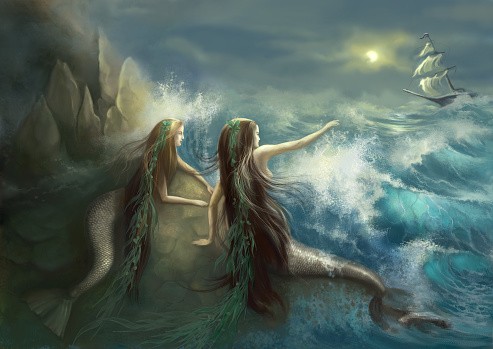In Greek mythology, Tethys , was a Titan daughter of Uranus and Gaia, sister and wife of Titan-god Oceanus, mother of the Potamoi and the Oceanids. Tethys had no active role in Greek mythology and no established cults.
Tethys was one of the Titan offspring of Uranus (Sky) and Gaia (Earth). Hesiod lists her Titan siblings as Oceanus, Coeus, Crius, Hyperion, Iapetus, Theia, Rhea, Themis, Mnemosyne, Phoebe, and Cronus. Tethys married her brother Oceanus, an enormous river encircling the world and was by him the mother of numerous sons, the Potamoi and numerous daughters, the Oceanids.
According to Hesiod, there were three thousand river-gods. These included: Achelous, the god of the Achelous River and the largest river in Greece who gave his daughter in marriage to Alcmaeon and was defeated by Heracles in a wrestling contest for the right to marry Deianira; Alpheus, who fell in love with the nymph Arethusa and pursued her to Syracuse where she was transformed into a spring by Artemis; and Scamander who fought on the side of the Trojans during the Trojan War and got offended when Achilles polluted his waters with a large number of Trojan corpses, overflowed his banks nearly drowning Achilles.
According to Hesiod, there were also three thousand Oceanids. These included: Metis, Zeus' first wife, whom Zeus impregnated with Athena and then swallowed; Eurynome, Zeus' third wife, and mother of the Charites; Doris, the wife of Nereus and mother of the Nereids; Callirhoe, the wife of Chrysaor and mother of Geryon; Clymene, the wife of Iapetus, and mother of Atlas, Menoetius, Prometheus, and Epimetheus; Perseis, wife of Helios and mother of Circe and Aeetes; Idyia, wife of Aeetes and mother of Medea; and Styx, goddess of the river Styx, and the wife of Pallas and mother of Zelus, Nike, Kratos and Bia.
According to one myth, Hera did not like that Callisto and Arcas were placed in the heavens by being turned into the constellations Ursa Major and Ursa Minor, so she asked Tethys to do something about it. To appease Hera, Tethys denied the constellations from being able to touch the sea and fall below the horizon; instead, they were forever doomed to circle the sky.
Passages in a section of the Iliad called the Deception of Zeus, suggest the possibility that Homer knew a tradition in which Oceanus and Tethys (rather than Uranus and Gaia, as in Hesiod) were the parents of the Titans. Twice Homer has Hera describe the pair as "Oceanus, from whom the gods are sprung, and mother Tethys", while in the same passage Hypnos describes Oceanus as "from whom they all are sprung". Gantz, points out that "mother" may simply refer to the fact that Tethys was Hera's foster mother for a time, as Hera tells us in the lines immediately following, while the reference to Oceanus as the genesis of the gods "might be simply a formulaic epithet indicating the numberless rivers and springs descended from Okeanos". However, for M. L. West, these lines suggests a myth in which Oceanus and Tethys are the "first parents of the whole race of gods." Perhaps as an attempt to reconcile this possible conflict between Homer and Hesiod, Plato, in his Timaeus, has Uranus and Gaia as the parents of Oceanus and Tethys, and Oceanus and Tethys as the parents of Cronus and Rhea and the other Titans, as well as Phorcys.


Comments
Post a Comment